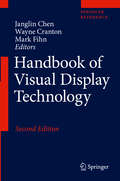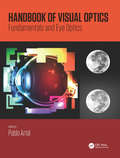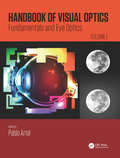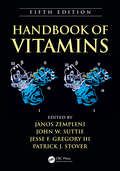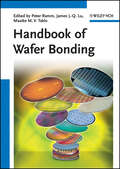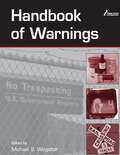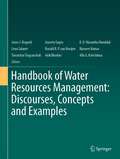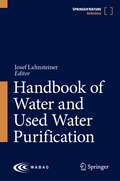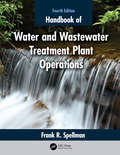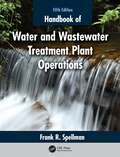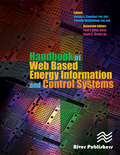- Table View
- List View
Handbook of Virtual Environments: Design, Implementation, and Applications, Second Edition (Human Factors and Ergonomics)
by Kelly S. Hale Kay M. StanneyA Complete Toolbox of Theories and TechniquesThe second edition of a bestseller, Handbook of Virtual Environments: Design, Implementation, and Applications presents systematic and extensive coverage of the primary areas of research and development within VE technology. It brings together a comprehensive set of contributed articles that address the
Handbook of Visual Display Technology
by Janglin Chen Wayne Cranton Mark FihnThis handbook offers a comprehensive description of the science, technology, economic and human interface factors associated with the displays industry. With expert contributions from over 150 international display professionals and academic researchers, it covers all classes of display device and discusses established principles, emergent technologies, and particular areas of application.
Handbook of Visual Display Technology
by Janglin Chen Wayne Cranton Mark FihnThe second Edition of this remarkable Handbook offers readers a comprehensive overview of the science and technology of visual displays and the economic and human interface factors associated with the displays industry. Unique in the displays field, the Handbook serves as a single reference source with expert contributions from over 150 international display professionals and academic researchers. The Handbook contains extensive coverage of established and emerging display technologies, with discussion of physical principles, materials science and processing, device technologies and particular areas of application. The wide-ranging content also encompasses the fundamental science of light and vision, image acquisition and manipulation, display materials and processing techniques, TFTs, display driving and metrology. Prominence is given to liquid crystal displays, with later chapters devoted to emerging technologies including flexible displays, electrophoretic, electrowetting and electrofluidic displays and MEMS-based displays. Other sections consider 3D display solutions, projection systems and head-worn displays. Updated and extended throughout, major changes in the 2nd Edition include: * Significantly expanded section on touch and human-computer interaction * Reworked and updated chapters on OLEDs * Revised and extended coverage of mobile display technologies ". . . no engineering or science library can be without this book. It will be an asset for all companies engaged in display and display-related business. " - extract from the Foreword of the 1st Edition by Dr M Anandan, President, Society for Information Display.
Handbook of Visual Optics, Two-Volume Set
by Pablo ArtalHandbook of Visual Optics offers an authoritative overview of encyclopedic knowledge in the field of physiological optics. It builds from fundamental concepts to the science and technology of instruments and practical procedures of vision correction, integrating expert knowledge from physics, medicine, biology, psychology, and engineering. The chapters comprehensively cover all aspects of modern study and practice, from optical principles and optics of the eye and retina to novel ophthalmic tools for imaging and visual testing, devices and techniques for visual correction, and the relationship between ocular optics and visual perception.
Handbook of Visual Optics, Volume Two: Instrumentation and Vision Correction
by Pablo ArtalHandbook of Visual Optics offers an authoritative overview of encyclopedic knowledge in the field of physiological optics. It builds from fundamental concepts to the science and technology of instruments and practical procedures of vision correction, integrating expert knowledge from physics, medicine, biology, psychology, and engineering. The chapters comprehensively cover all aspects of modern study and practice, from optical principles and optics of the eye and retina to novel ophthalmic tools for imaging and visual testing, devices and techniques for visual correction, and the relationship between ocular optics and visual perception.
Handbook of Visual Optics: Fundamentals and Eye Optics, Volume One
by Pablo ArtalHandbook of Visual Optics offers an authoritative overview of encyclopedic knowledge in the field of physiological optics. It builds from fundamental concepts to the science and technology of instruments and practical procedures of vision correction, integrating expert knowledge from physics, medicine, biology, psychology, and engineering. The chapters comprehensively cover all aspects of modern study and practice, from optical principles and optics of the eye and retina to novel ophthalmic tools for imaging and visual testing, devices and techniques for visual correction, and the relationship between ocular optics and visual perception.
Handbook of Vitamins
by Patrick J. Stover Janos Zempleni John W. Suttie Jesse F. Gregory IIIWithin the last few years, knowledge about vitamins has increased dramatically, resulting in improved understanding of human requirements for many vitamins. This new edition of a bestseller presents comprehensive summaries that analyze the chemical, physiological, and nutritional relationships, as well as highlight newly identified functions, for a
Handbook of Wafer Bonding
by Maaike M. Taklo James Jian-Qiang Lu Peter RammThe focus behind this book on wafer bonding is the fast paced changes in the research and development in three-dimensional (3D) integration, temporary bonding and micro-electro-mechanical systems (MEMS) with new functional layers. Written by authors and edited by a team from microsystems companies and industry-near research organizations, this handbook and reference presents dependable, first-hand information on bonding technologies. Part I sorts the wafer bonding technologies into four categories: Adhesive and Anodic Bonding; Direct Wafer Bonding; Metal Bonding; and Hybrid Metal/Dielectric Bonding. Part II summarizes the key wafer bonding applications developed recently, that is, 3D integration, MEMS, and temporary bonding, to give readers a taste of the significant applications of wafer bonding technologies.This book is aimed at materials scientists, semiconductor physicists, the semiconductor industry, IT engineers, electrical engineers, and libraries.
Handbook of Warnings (Human Factors and Ergonomics)
by Michael S. WogalterA technical discussion that includes theory, research, and application, this book describes warning design standards and guidelines; aspects of law relevant to warnings such as government regulations, case/trial litigation, and the role of expert testimony in these cases; and international, health/medical, and marketing issues. Broken into thirteen
Handbook of Waste Biorefinery: Circular Economy of Renewable Energy
by Eduardo Jacob-Lopes Leila Queiroz Zepka Mariany Costa DepráThis handbook discusses the latest developments in biorefinery technologies for waste-to-energy conversion. The growing global population and the accompanying increase in consumption and waste production make it urgent to find the best possible use of our resources. A sustainable waste management under the biorefinery concept has great potential to support a sustainable circular economy and green energy production.This handbook is divided into four parts. First, the reader is introduced to the fundamentals and recent trends of waste-to-energy technologies. The second part describes in detail the current status, challenges, and potential of the different feedstocks used for waste-to-energy conversion. Here, municipal solid waste, sewage sludge, oils and greases generated during food preparation, industrial wastewaters, and agricultural wastes, to name a few, are introduced. In the third part, numerous waste-to-energy technologies are discussed in detail, including anaerobic digestion, composting, gasification, plasma technology, thermal cracking, and others. Advantages and optimization potentials of these technologies for efficient residue management, quality and yield are highlighted.Finally, the handbook discusses social, environmental and economic aspects of waste-to-energy biorefinery technologies. Readers will learn more about the major bottlenecks and solutions in bioenergy commercialization, the logistics of biomass supply and the carbon footprint of waste biorefineries. The ideas and technologies presented in this book contribute to the UN Sustainable Development Goal (SDG) of "Affordable and Clean Energy".This book is a useful reference for postgraduate students and researchers interested in biorefinery and biofuel technologies, both in academia- and commercial laboratories. Early career scientists can use it to fast track into the field. Advanced scientists will find it helpful in gaining a broader overview of the field beyond their area of specialization.
Handbook of Wastewater Reclamation and Reuse
by Donald R. Rowe Isam Mohammed Abdel-MagidThis comprehensive reference provides thorough coverage of water and wastewater reclamation and reuse. It begins with an introductory chapter covering the fundamentals, basic principles, and concepts. Next, drinking water and treated wastewater criteria, guidelines, and standards for the United States, Europe and the World Health Organization (WHO) are presented. Chapter 3 provides the physical, chemical, biological, and bacteriological characteristics, as well as the radioactive and rheological properties, of water and wastewater. The next chapter discusses the health aspects and removal treatment processes of microbial, chemical, and radiological constituents found in reclaimed wastewater. Chapter 5 discusses the various wastewater treatment processes and sludge treatment and disposal. Risk assessment is covered in chapter 6. The next three chapters cover the economics, monitoring (sampling and analysis), and legal aspects of wastewater reclamation and reuse.This practical handbook also presents real-world case studies, as well as sources of information for research, potential sources for research funds, and information on current research projects. Each chapter includes an introduction, end-of-chapter problems, and references, making this comprehensive text/reference useful to both students and professionals.
Handbook of Water Analysis
by Leo M. L. Nollet Leen S. P. De GelderExtensively revised and updated, Handbook of Water Analysis, Third Edition provides current analytical techniques for detecting various compounds in water samples. Maintaining the detailed and accessible style of the previous editions, this third edition demonstrates water sampling and preservation methods by enumerating different ways to measure c
Handbook of Water Harvesting and Conservation: Basic Concepts and Fundamentals (New York Academy of Sciences)
by Saeid Eslamian Faezeh EslamianWater harvesting is gaining more and more recognition as a sustainable and resilient water supply options. It is economically viable, socially compatible and environmentally friendly. Water harvesting has proven to be a robust solution to overcome or reduce water shortages all over the world. It is important to understand how to apply this practice in a sustainable and effective way to make full use of its potential in a world increasingly threatened by water scarcity. The Handbook of Water Harvesting and Conservation: Basic Concepts and Fundamentals is the most comprehensive, up-to-date and applied handbook on water harvesting and conservation yet published. The book’s 30 chapters -- written by 84 outstanding international experts from approximately 20 selected countries faced by drought -- explore, critique and develop concepts and systems for water harvesting. The editors bring together many perspectives into a synthesis that is both academically based and practical in its potential applications. The Handbook of Water Harvesting and Conservation: Basic Concepts and Fundamentals is an important tool for education, research and technical works in the areas of soil, water and watershed management and is highly useful for drought strategy planning, flood management and developing techniques to adapt to climate change in urban, agricultural, forest and rangeland areas.
Handbook of Water Harvesting and Conservation: Case Studies and Application Examples (New York Academy of Sciences)
by Saeid EslamianWater harvesting is gaining more and more recognition as the sustainable and resilient alternative to other water supply options. It is economically viable, socially compatible and environmentally friendly. Water harvesting has proven to be a robust solution to overcome or reduce water shortages all over the world. To apply this in a sustainable and effective way, it is important to understand exactly where it can be applied to make full use of its potential. The Handbook of Water Harvesting and Conservation: Case Studies and Application Examples is the most comprehensive, up-to-date and applied casebook on water harvesting and conservation yet published. The editors bring together the many perspectives into a synthesis that is both academically-based and practical in its potential applications. The Handbook of Water Harvesting and Conservation: Case Studies and Application Examples will be an important tool for education, research and technical works in the soil, water and watershed management area, and will be highly useful for drought strategy planning, flood management and adaptation to climate change in all urban, agricultural, forest, rangeland areas.
Handbook of Water Pollution
by Inamuddin Tariq Altalhi Arwa AlrooqiHANDBOOK of WATER POLLUTION Handbook of Water Pollution discusses a wide range of contaminants heavily affecting our environment and water bodies. The chapters discuss heavy metals, metalloids, pesticides, explosives, toxic chemicals, dyes, plastics, e-wastes, fertilizers, detergents, nitrates/nitrites, phosphates, hydrocarbons, and fecal wastes, along with their sources of action against our environment, their methods of analysis, and finally, their treatments are all presented in detail. Our environment is heavily affected due to extreme human activities. Environmental pollution is a major concern worldwide. Within this, water pollution is one of the major challenges that puts the total ecology at risk. Water pollution is alarming everywhere; many governing authorities believe it is also an unavoidable result of human activity. However, the economic cost of water pollution far outweighs the benefits of skimping on its cause. Water pollution is not just merely related to financial cost but related to all living beings. Toxic waste is getting into the water bodies in various regions, causing many illnesses in humans and poisoning other living things. The destruction of any single component of our ecosystem can have a devastating effect on our biodiversity. Therefore, it is necessary to understand the causes of pollution, their nature and mechanism, and, at the same time, study the remedies. The major causes of water pollution are industrial waste, sewage, plastics, oil leakage, biological organisms, toxic chemicals and radioactive waste, and so on. A tremendous amount of research work is going on around the world to understand the causes, their mechanism, and solutions. Many new works are published every day, therefore it’s important to gather some of the most relevant findings in one place. This will serve as a link between collected knowledge and current advancements, while also facilitating future thinking.
Handbook of Water Resources Management: Discourses, Concepts and Examples
by Joyeeta Gupta Anik Bhaduri Janos J. Bogardi K. D. Wasantha Nandalal Léna Salamé Ronald R. P. van Nooijen Navneet Kumar Tawatchai Tingsanchali Alla G. KolechkinaThis book provides an overview of facts, theories and methods from hydrology, geology, geophysics, law, ethics, economics, ecology, engineering, sociology, diplomacy and many other disciplines with relevance for concepts and practice of water resources management. It provides comprehensive, but also critical reading material for all communities involved in the ongoing water discourses and debates.The book refers to case studies in the form of boxes, sections, or as entire chapters. They illustrate success stories, but also lessons to be remembered, to avoid repeating the same mistakes. Based on consolidated state-of-the-art knowledge, it has been conceived and written to attract a multidisciplinary audience.The aim of this handbook is to facilitate understanding between the participants of the international water discourse and multi-level decision making processes. Knowing more about water, but also about concepts, methods and aspirations of different professional, disciplinary communities and stakeholders professionalizes the debate and enhances the decision making.
Handbook of Water and Used Water Purification
by Josef LahnsteinerThe book addresses the entire water cycle. The focus is on new technologies/processes (especially in high performance biological treatment), energy recovery, water recycling and reuse. Recommendations with regard to the right technologies/processes for specific situations are provided and a wide range of case studies, especially in emerging markets. In addition, the most modern water terminology with more positive connotations is used. This is especially important in the field of direct and indirect potable reuse (DPR and IPR respectively).
Handbook of Water and Wastewater Systems Protection
by Simon Hakim Avi Ostfeld Robert M. ClarkFollowing the events of 9/11, the Administrator of the US Environmental Protection Agency created the Water Protection Task Force (WPTF), which identified water and wastewater systems as a major area of vulnerability to deliberate attack. The WPTF suggested that there are steps that can be taken to reduce these vulnerabilities and to make it as difficult as possible for potential saboteurs to succeed. The WPTF recommended that be scrutinized with renewed vigor to secure water and wastewater systems against these possible threats. It also recommended that water and wastewater systems have a response plan in place in the event an act of terrorism occurs. The WPTF identified water distribution networks as an area of special vulnerability and highlighted the need for rapid on-line detection methods that are accurate and have a wide detection range. As a result of these recommendations novel technologies from various fields of science and engineering are now addressing water security issues and water and wastewater utilities are looking for innovative solutions. Once such technologies are available, there will be a rapid implementation process that will present many business opportunities for the private sector. However, in addition to terrorist threats water and wastewater systems are inherently vulnerable to natural disasters such as earthquakes and floods. This volume will address the problems associated with both intended terrorist attacks and natural disasters affecting water or wastewater systems. The book is divided into parts based on the kinds of threats facing water and wastewater systems: (1) a direct attack on water and wastewater infrastructure storage reservoirs, and distribution and collection networks; (2) a cyber attack disabling the functionality of the water and wastewater systems or taking over control of key components which might result in system failures; and (3) a deliberate chemical or biological contaminant injection at one of the water distribution system's nodes. It will examine unique plans, technological and managerial innovations for protecting such systems, and includes descriptions of projects that were implemented to respond to natural disasters. Case studies are presented that discuss existing projects and evaluate their performance, with an emphasis on providing guidelines and techniques that can be implemented by water and wastewater planners and managers to deal with natural and manmade disasters should they occur.
Handbook of Water and Wastewater Treatment Plant Operations
by Frank R. SpellmanThe Handbook of Water and Wastewater Treatment Plant Operations is the first thorough resource manual developed exclusively for water and wastewater plant operators. Now regarded as an industry standard, this fourth edition has been updated throughout, and explains the material in easy-to-understand language. It also provides real-world case studies and operating scenarios, as well as problem-solving practice sets for each scenario. Features: Updates the material to reflect the developments in the field Includes new math operations with solutions, as well as over 250 new sample questions Adds updated coverage of energy conservation measures with applicable case studies Enables users to properly operate water and wastewater plants and suggests troubleshooting procedures for returning a plant to optimum operation levels Prepares operators for licensure exams A complete compilation of water science, treatment information, process control procedures, problem-solving techniques, safety and health information, and administrative and technological trends, this text serves as a resource for professionals working in water and wastewater operations and operators preparing for wastewater licensure exams. It can also be used as a supplemental textbook for undergraduate and graduate students studying environmental science, water science, and environmental engineering.
Handbook of Water and Wastewater Treatment Plant Operations
by Frank R. SpellmanThe Handbook of Water and Wastewater Treatment Plant Operations is the first thorough resource manual developed exclusively for water and wastewater plant operators. Now regarded as an industry standard, this fifth edition has been updated throughout, and it explains the material in easy-to-understand language. It also provides real-world case studies and operating scenarios, as well as problem-solving practice sets for each scenario. Key features: Updates the material to reflect the developments in the field Includes new math operations with solutions, as well as over 250 new sample questions Adds updated coverage of energy conservation measures with applicable case studies Enables users to properly operate water and wastewater plants and suggests troubleshooting procedures for returning a plant to optimum operation levels Prepares operators for licensure exams
Handbook of Water and Wastewater Treatment Technology
by Paul N. CheremisinoffOffers information on the treatment of water and wastewater for municipal, sanitary and industrial applications, focusing on unit operations and processes that serve the broadest range of users. Wastewater treatement unit operations, including filtration, flotation, chemical coagulation, flocculation and sedimentation, as well as advanced technolog
Handbook of Weaving
by Sabit AdanurA mixture of science and art, weaving is nearly as old as human history. Despite the many technological advances in the field, however, it is still virtually impossible to control each individual fiber in a woven structure. To help you meet this and other weaving challenges, Handbook of Weaving covers every step of the process clearly and systemati
Handbook of Web Based Energy Information and Control Systems
by Barney L. Capehart Timothy MiddelkoopThis book promotes the benefits of the development and application of energy information and control systems. This wave of information technology (IT) and web-based energy information and control systems (web based EIS/ECS) continues to roll on with increasing speed and intensity. This handbook presents recent technological advancements in the field, as well as a compilation of the best information from three previous books in this area. The combined thrust of this information is that the highest level functions of the building and facility automation system are delivered by a web based EIS/ECS system that provides energy management, facility management, overall facility operational management and ties in with the enterprise resource management system for the entire facility or the group of facilities being managed.
Handbook of Wind Energy Aerodynamics
by Bernhard Stoevesandt Gerard Schepers Peter Fuglsang Yuping SunThis handbook provides both a comprehensive overview and deep insights on the state-of-the-art methods used in wind turbine aerodynamics, as well as their advantages and limits. The focus of this work is specifically on wind turbines, where the aerodynamics are different from that of other fields due to the turbulent wind fields they face and the resultant differences in structural requirements. It gives a complete picture of research in the field, taking into account the different approaches which are applied. This book would be useful to professionals, academics, researchers and students working in the field.
Handbook of Wind Power Systems
by Panos M. Pardalos Niko A. Iliadis Steffen Rebennack Vijay Pappu Mario V. F. PereiraWind power is currently considered as the fastest growing energy resource in the world. Technological advances and government subsidies have contributed in the rapid rise of Wind power systems. The Handbook on Wind Power Systems provides an overview on several aspects of wind power systems and is divided into four sections: optimization problems in wind power generation, grid integration of wind power systems, modeling, control and maintenance of wind facilities and innovative wind energy generation. The chapters are contributed by experts working on different aspects of wind energy generation and conversion.


